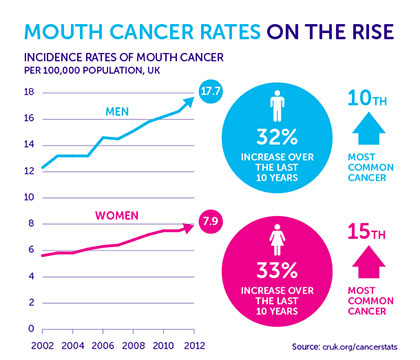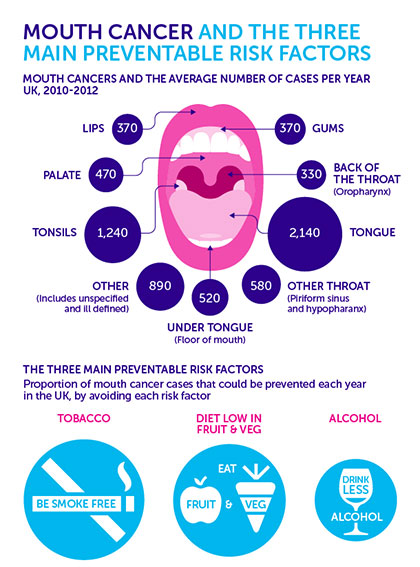by
Lee Waring
| Jan 19, 2017
Over the decades, our society has changed enormously – and with it our lifestyles.
And because the rates of many types of cancer are linked to things we do (or not) every day, as well as our jobs and things in our environment, cancer rates have changed too.
In 2012 oral cancers were the 10th most common cancer in UK men, and 15th most common in UK women. That’s compared to 13th in men, and 17th in women, back in 2002.
To put this in context, that’s currently 21 cases of oral cancer diagnosed every day.

The most common anatomical sites for oral cancers
The majority of oral cancers – around 4 in 5 cases – are cancers of the tongue, the inside of the mouth, tonsils, and oropharynx.
In fact, the rate of people being diagnosed with tongue, tonsil and oropharyngeal cancers has increased by almost 60%in the last 10 years.
Or in terms of cases, that’s an increase from around 2,100 to 3,700 people diagnoses with oral cancer a year in the UK.

Why the increase?
So which of these risk factors is to contributing for the rising rates?
Evidence suggests that tobacco, not eating enough fruit and vegetables, and drinking alcohol all increase the risk of oral cancer.
In fact, smoking is linked to around two thirds of oral cancer cases, not eating enough fruit and veg is linked to more than half. And alcohol is linked to just less than a third
If you’re mathematically inclined, you’ll notice that two thirds, plus a half, plus a third is more than all cases of oral cancer.
That’s because, for many cases, there’s more than one factor involved. For example, people who smoke might also drink alcohol regularly. And people who drink regularly, might not always eat five-a-day, every day. The studies used to make these calculations did take into account that people might do more than one of these things – but if we look at the risk factors separately, they make up the fractions above.
So what’s been happening to these risk factors over time?
First, the good news: the rate of smoking has decreased overall in Great Britain in the past 40 years or so.
But this doesn’t mean that the number of smoking-related cancers is also decreasing.
If we look at smoking rates and lung cancer data, yes – the rate of lung cancer in men is falling following the decline in smoking rates. But the rate of lung cancer in women is increasing.
This is due to the rise in smoking rates in women in the 1950s and 60s, which could be contributing to the increase in oral cancer rates. We do expect to see a decline in lung cancer rates in women though, much like we have seen in men.
Smoking is the leading preventable cause of cancer globally and giving up is the most important thing you can do for your health. Encouraging your patients to stop smoking and directing them to their local stop smoking services is the most effective way for them to quit for good.
Is it the same for alcohol?
The Office for National Statistics recently reported a decline in adult drinkers in Great Britain. But this decline only started in 2005.
Public Health England used statistics from the British Beer and Pub Association to show that if we step back further in time, a different trend emerges
There was an increase in the average amount of alcohol people drank in the UK, with the amount the UK drinks has nearly doubled since the 1960s. This is likely to result in an increase in oral cancers later on.
For fruit and veg consumption it’s a bit more complicated. The Health Survey for England recently published data showing that only a 25% men, 28% of women and 16 per cent of children in England are getting their five-a-day. This seems pretty low.
The data also tell us that the percentages peaked in 2006 and have since fallen. This makes it difficult to draw any conclusions about the trends in fruit and veg consumption and whether it has affected the trend in oral cancer rates.
But there’s also another cause of oral cancers, for which evidence has been growing in recent years: the human papillomavirus (HPV) – more commonly linked to cervical cancer.
What about HPV?
Up to 8 out of 10 people will be infected with HPV at some point in their lives. So the infection is extremely common, but although there are over 100 types of HPV, only 13 are linked to cancer. In many cases the body’s natural defences will fight off the infection without the person ever knowing.
But in some cases the infection persists, triggering a series of events that can lead to cancer. Researchers are trying to pin down exactly what these events are, and use this information to tackle these cancers.
Either way, the evidence suggests that about 7 in every 100 oral cancers in the UK are linked to HPV – that’s far fewer than are caused by smoking, drinking alcohol or not eating your five-a-day.
These may seem like worrying statistics, so what can be done to halt the rise?
In fact, 91% of oral cancer cases could potentially be prevented. The disease is more common among people who:
- Smoke
- have a diet low in fruit and vegetables
- drink alcohol
- some cases are linked to infection with the human papillomavirus (HPV)
Dentists are uniquely well placed to support patients in reducing their risk of oral cancer and to identify and refer suspected oral cancer cases – a major reason why it’s so important to have regular check-ups and maintain a good oral hygiene routine!